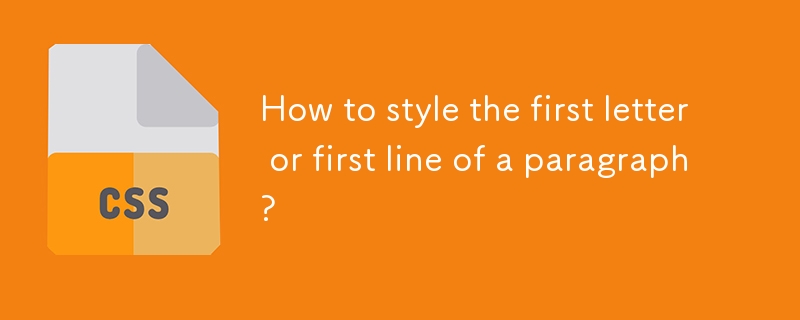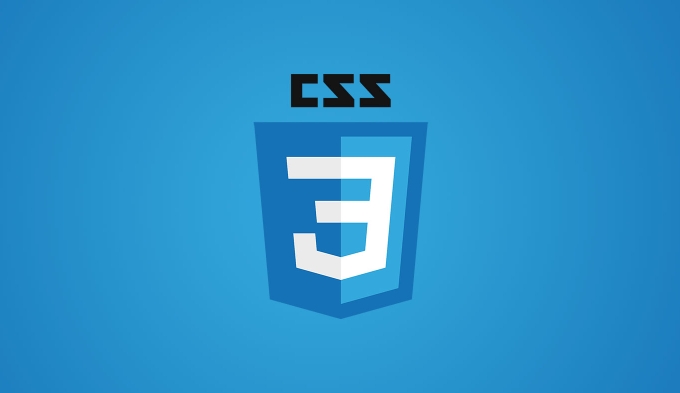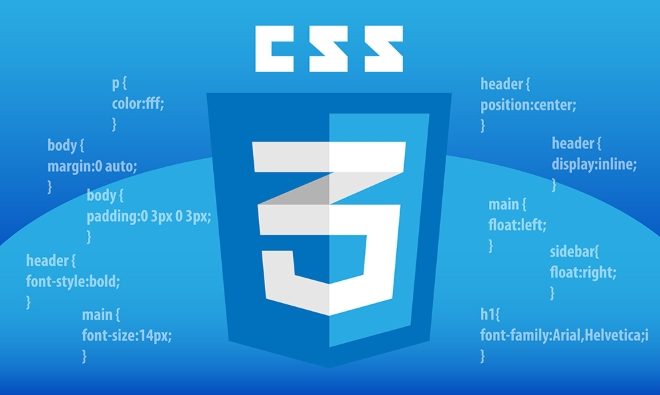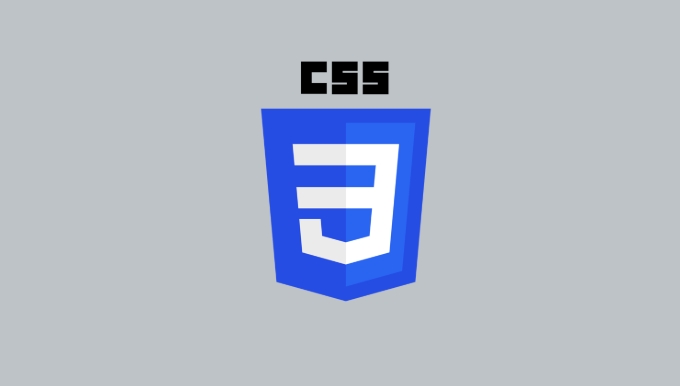How to style the first letter or first line of a paragraph?
 <p> If you want to make the beginning of a paragraph more design, the most common way is to beautify the first letter or first line. This is particularly common in web layout, e-books, and blog posts, and can enhance the overall reading experience and visual appeal. It is not difficult to implement, but the details need to be paid attention to.
<p> If you want to make the beginning of a paragraph more design, the most common way is to beautify the first letter or first line. This is particularly common in web layout, e-books, and blog posts, and can enhance the overall reading experience and visual appeal. It is not difficult to implement, but the details need to be paid attention to.

Use CSS to style the first letter of the paragraph
<p> If you are doing web development or blogging, CSS provides pseudo-element::first-letter to specifically control the first character of the paragraph.
<p> For example, if you want the first letter of the paragraph to be larger, bolder, and colored, you can write it like this:

p::first-letter {
font-size: 2em;
font-weight: bold;
color: #8B0000;
}<p> This way the first letter in each <p> tag will be controlled by a separate style. Note that this pseudo-element is only applicable to block-level elements (such as <p> ) and cannot be applied to inline elements like <span> .<p> Some tips: 
- If you want the initial letter to be decorated with a little or no decoration, such as italics or different fonts, you can also add
font-familyorfont-style - If you want the initial letter to sink (like a magazine), you can combine it with floating to achieve it.
- Be careful not to set too complicated styles to avoid affecting readability
Style the first line of the paragraph: Use ::first-line
<p> In addition to the initial letter, sometimes we also want to highlight the first line of the whole paragraph. At this time, you can use the ::first-line pseudo-element.<p> For example, make the first line of each paragraph darker and bolder: p::first-line {
color: #333;
font-weight: bold;
}<p> It supports many common text styles, including color, font size, font weight, background color, etc. However, it should be noted that not all styles are applicable, and some layout-related attributes (such as margin and padding) are invalid here.
<p> Examples of application scenarios:
- Guided reading of the blog's main text
- The beginning paragraph of the chapter in the e-book
- When it is necessary to emphasize the theme of the paragraph
How to operate in Word or typewriting software?
<p> If you are not writing web pages, but using document editing tools such as Word or Pages, the method is different. <p> There is no direct "first letter capitalization" function in Word, but you can manually select the first letter and set a larger font size, bold, etc. If you use this style frequently, it is recommended to create a "Paragraph First Letter" style template for easy reuse. <p> In addition, in professional typesetting software such as InDesign, there is a built-in function of "first character sinking", which can be directly dragged and dropped, which is very convenient and suitable for publication design.Ending reminder
<p> Whether it is a web page or a document, these techniques are actually not complicated, but details are easily overlooked. For example, the usage conditions and style conflicts of pseudo-elements in HTML/CSS, or the format confusion caused by manual adjustment in document layout. Just try a few more times and you can master the way that suits your content style. <p> Basically all that is it, try which project is more suitable for you!The above is the detailed content of How to style the first letter or first line of a paragraph?. For more information, please follow other related articles on the PHP Chinese website!

Hot AI Tools

Undress AI Tool
Undress images for free

Undresser.AI Undress
AI-powered app for creating realistic nude photos

AI Clothes Remover
Online AI tool for removing clothes from photos.

Clothoff.io
AI clothes remover

Video Face Swap
Swap faces in any video effortlessly with our completely free AI face swap tool!

Hot Article

Hot Tools

Notepad++7.3.1
Easy-to-use and free code editor

SublimeText3 Chinese version
Chinese version, very easy to use

Zend Studio 13.0.1
Powerful PHP integrated development environment

Dreamweaver CS6
Visual web development tools

SublimeText3 Mac version
God-level code editing software (SublimeText3)

Hot Topics
 1794
1794
 16
16
 1740
1740
 56
56
 1591
1591
 29
29
 1473
1473
 72
72
 267
267
 587
587
 How to use PHP to develop a Q&A community platform Detailed explanation of PHP interactive community monetization model
Jul 23, 2025 pm 07:21 PM
How to use PHP to develop a Q&A community platform Detailed explanation of PHP interactive community monetization model
Jul 23, 2025 pm 07:21 PM
1. The first choice for the Laravel MySQL Vue/React combination in the PHP development question and answer community is the first choice for Laravel MySQL Vue/React combination, due to its maturity in the ecosystem and high development efficiency; 2. High performance requires dependence on cache (Redis), database optimization, CDN and asynchronous queues; 3. Security must be done with input filtering, CSRF protection, HTTPS, password encryption and permission control; 4. Money optional advertising, member subscription, rewards, commissions, knowledge payment and other models, the core is to match community tone and user needs.
 How to use PHP to build social sharing functions PHP sharing interface integration practice
Jul 25, 2025 pm 08:51 PM
How to use PHP to build social sharing functions PHP sharing interface integration practice
Jul 25, 2025 pm 08:51 PM
The core method of building social sharing functions in PHP is to dynamically generate sharing links that meet the requirements of each platform. 1. First get the current page or specified URL and article information; 2. Use urlencode to encode the parameters; 3. Splice and generate sharing links according to the protocols of each platform; 4. Display links on the front end for users to click and share; 5. Dynamically generate OG tags on the page to optimize sharing content display; 6. Be sure to escape user input to prevent XSS attacks. This method does not require complex authentication, has low maintenance costs, and is suitable for most content sharing needs.
 PHP creates a blog comment system to monetize PHP comment review and anti-brush strategy
Jul 25, 2025 pm 08:27 PM
PHP creates a blog comment system to monetize PHP comment review and anti-brush strategy
Jul 25, 2025 pm 08:27 PM
1. Maximizing the commercial value of the comment system requires combining native advertising precise delivery, user paid value-added services (such as uploading pictures, top-up comments), influence incentive mechanism based on comment quality, and compliance anonymous data insight monetization; 2. The audit strategy should adopt a combination of pre-audit dynamic keyword filtering and user reporting mechanisms, supplemented by comment quality rating to achieve content hierarchical exposure; 3. Anti-brushing requires the construction of multi-layer defense: reCAPTCHAv3 sensorless verification, Honeypot honeypot field recognition robot, IP and timestamp frequency limit prevents watering, and content pattern recognition marks suspicious comments, and continuously iterate to deal with attacks.
 How to style the first letter or first line of a paragraph?
Jul 19, 2025 am 02:58 AM
How to style the first letter or first line of a paragraph?
Jul 19, 2025 am 02:58 AM
To beautify the beginning of a paragraph to enhance visual appeal, a common practice is to use pseudo-elements of CSS or manually style the document. In web development, p::first-letter can be used to set the first letter style, such as enlarging, bolding, and discoloring, but it should be noted that it is only suitable for block-level elements; if you want to highlight the entire first line, use p::first-line to add styles; in document software such as Word, you can manually adjust the first letter format or create style templates, and InDesign has a built-in "first-sinking" function suitable for publishing and design; when applying, you need to pay attention to details, such as avoiding complex styles affecting reading and ensuring compatibility and format consistency.
 Free entrance to Vue finished product resources website. Complete Vue finished product is permanently viewed online
Jul 23, 2025 pm 12:39 PM
Free entrance to Vue finished product resources website. Complete Vue finished product is permanently viewed online
Jul 23, 2025 pm 12:39 PM
This article has selected a series of top-level finished product resource websites for Vue developers and learners. Through these platforms, you can browse, learn, and even reuse massive high-quality Vue complete projects online for free, thereby quickly improving your development skills and project practice capabilities.
 What is the purpose of the CSS `will-change` property?
Jul 23, 2025 am 03:47 AM
What is the purpose of the CSS `will-change` property?
Jul 23, 2025 am 03:47 AM
will-change is a CSS property that is used to inform browser elements in advance of possible changes to optimize performance. Its core function is to enable the browser to create layers in advance to improve rendering efficiency. Common values include transform, opacity, etc., and can also be separated by multiple attribute commas; it is suitable for non-standard attribute animations, complex component transitions and user interaction triggered animations; but it must be avoided abuse, otherwise it will lead to excessive memory usage or increased GPU load; the best practice is to apply before the change occurs and remove it after it is completed.
 Describe the structure of a CSS rule set
Jul 20, 2025 am 02:49 AM
Describe the structure of a CSS rule set
Jul 20, 2025 am 02:49 AM
The CSS rule set consists of selectors and declaration blocks to define the style of HTML elements. 1. The selector specifies the target element, such as a tag, class, or ID; 2. Declare the block to contain attributes and values to control the appearance of the element. For example: p{color:blue;font-size:16px;} means selecting the paragraph and setting the text color and font size. Master these two parts to write effective CSS styles.
 Explain the different CSS positioning schemes: static, relative, absolute, fixed, sticky
Jul 19, 2025 am 03:19 AM
Explain the different CSS positioning schemes: static, relative, absolute, fixed, sticky
Jul 19, 2025 am 03:19 AM
There are five ways to locate CSS: static, relative, absolute, fixed and sticky. static is the default positioning, following the document flow and does not support offset; relative moves relative to its original position and is still in the document flow; absolute is separated from the document flow, and is positioned relative to the nearest non-static positioning and ancestor positioning; fixed relative to the browser window, and is often used to fix the navigation bar; sticky is between relative and fixed, scrolling to a specific position and fixed, suitable for sticky heads. Mastering their behavioral differences is key to layout.





